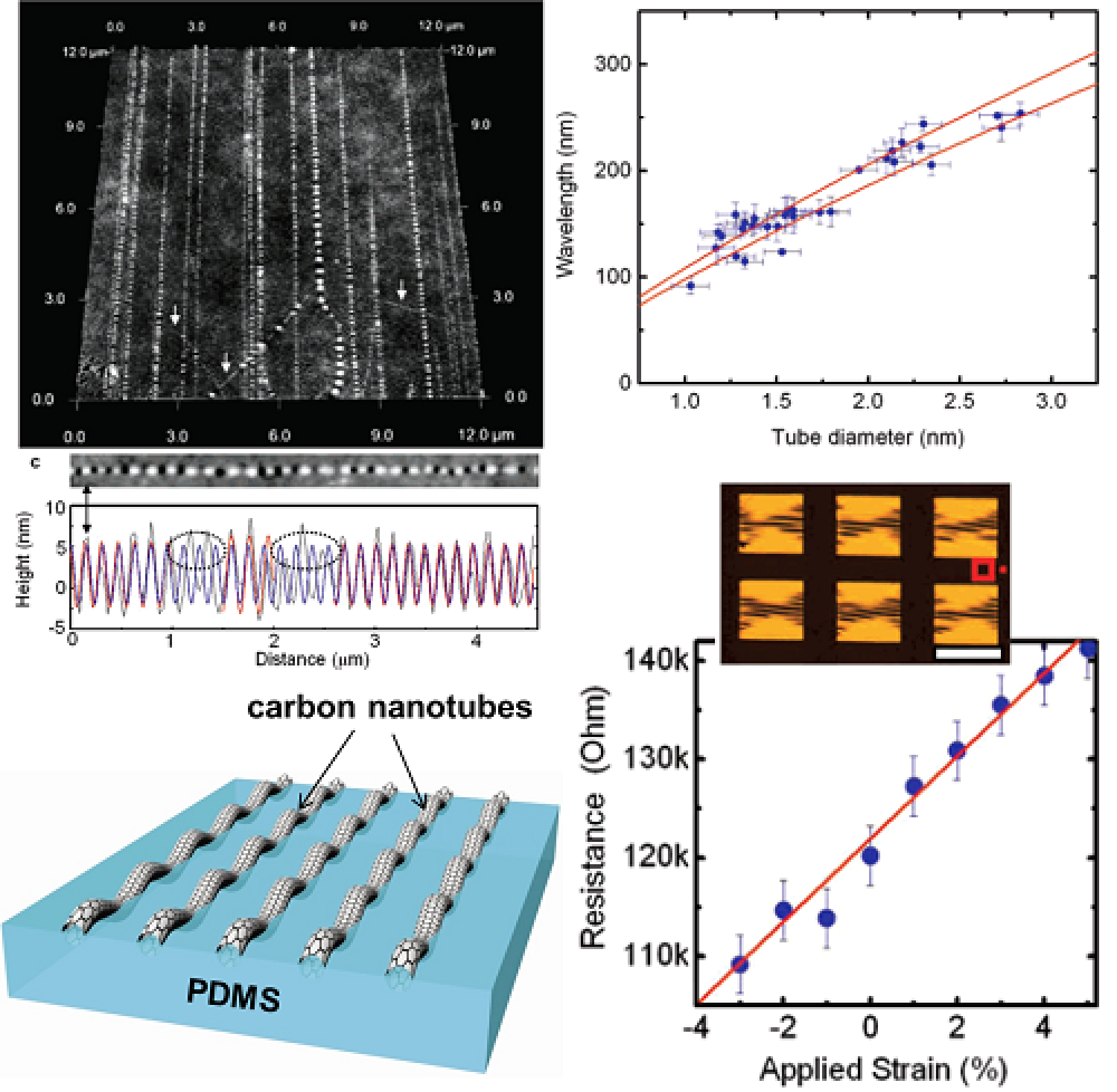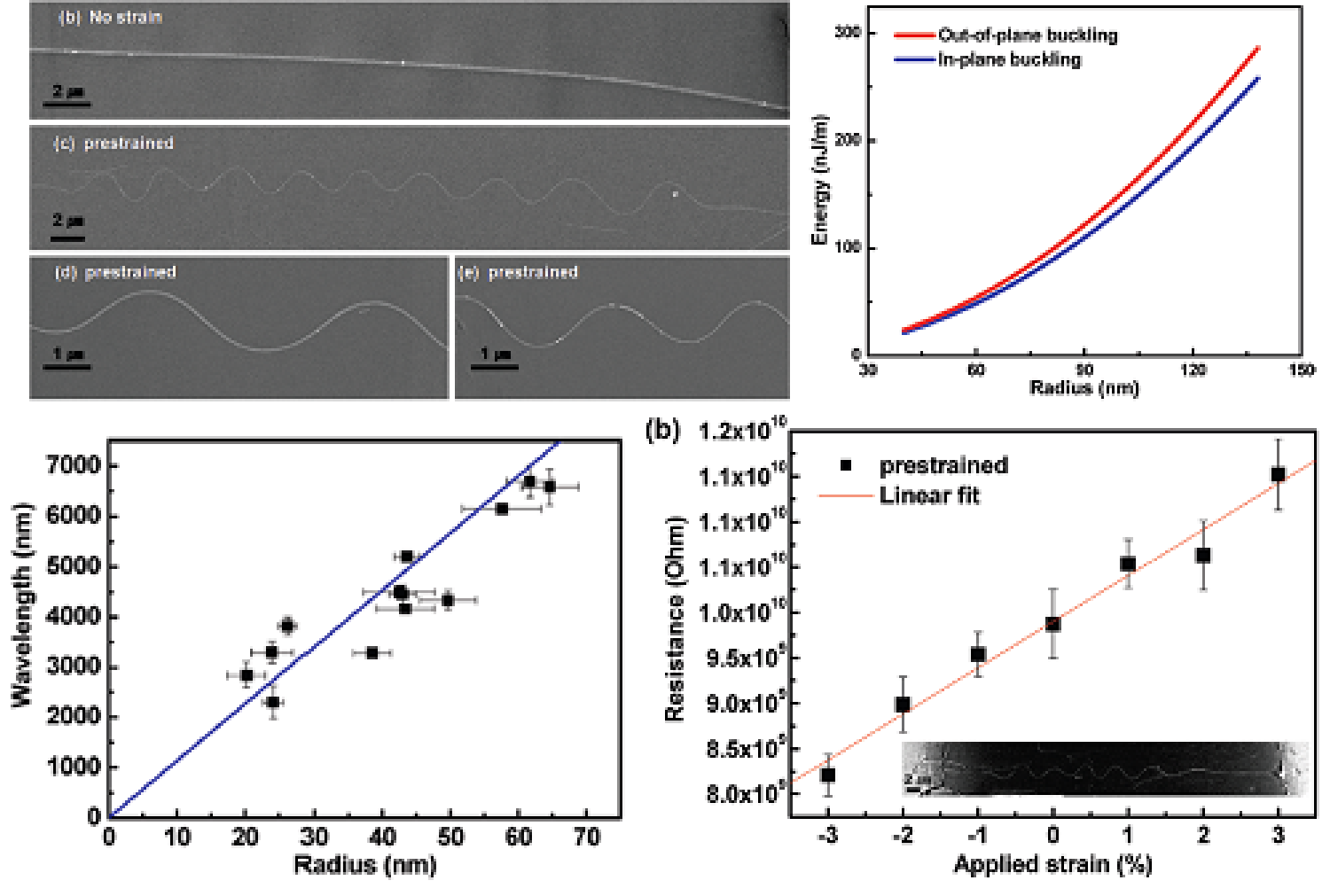By engineering the strain mismatch between adhered stiff thin films and soft substrates, nonlinear wrinkling (buckling) of thin films can create well-controlled wavy surface features. This capability can lead to lots of interesting applications, such as stretchable electronics, precision metrology, smart adhesion and friction, controllable wetting, optical gratings, and sensing and actuating devices. We are interested in novel surface engineering by utilizing nonlinear wrinkling mechanics. We also explore novel materials for such phenomena, such as carbon nanotubes and silicon nanowires. Underlying mechanics and physics are also studied through analytical or numerical means.
Nonlinear Buckling of Silicon Ribbons on Elastomers
In previous studies of thin film wrinkling on soft substrates, the mechanics models usually assume plane-strain deformation, which was found to disagree with experimental observations for narrow thin films. Systematic experimental and analytical studies are conducted for buckling of finite-width stiff thin films on compliant substrates. Both experiments and analytical solution show that the buckling amplitude and wavelength increase with the film width.The effect of film spacing is also studied via the analytical solutions for two thin films and for periodic thin films.
References:
H. Jiang, D.-Y. Khang, H. Fei, H. Kim, Y. Huang, J. Xiao, and J. A. Rogers, Finite Width Effect of Thin-Films Buckling on Compliant Substrate: Experimental and Theoretical Studies. J. Mech. Phys. Solids 56, 2585-2598 (2008).
Molecular Scale Buckling Mechanics of Carbon Nanotubes on Elastomers
We have studied for the first time the scaling of controlled nonlinear buckling processes in materials with dimensions in the molecular range (i.e., ~1 nm) through experimental and theoretical studies of buckling in individual single-wall carbon nanotubes on substrates of poly(dimethylsiloxane). The results show not only the ability to create and manipulate patterns of buckling at these molecular scales, but also, that analytical continuum mechanics theory can explain, quantitatively, all measurable aspects of this system. Inverse calculation applied to measurements of diameter dependent buckling wavelengths yields accurate values of the Young’s moduli of individual SWNTs. As an example of the value of this system beyond its use in this type of molecular scale metrology, we implement parallel arrays of buckled SWNTs as a class of mechanically stretchable conductor.
References:
- D.-Y. Khang, J. Xiao, C. Kocabas, S. Maclaren, T. Banks, H. Jiang, Y. Y. Huang, and J. A. Rogers, Molecular Scale Buckling Mechanics in Individual Aligned Single-Wall Carbon Nanotubes on Elastomeric Substrates. Nano Lett. 8, 124-130 (2008).
- J. Xiao, H. Jiang, D.-Y. Khang, J. Wu, Y. Huang, and J.A. Rogers, Mechanics of buckled carbon nanotubes on elastomeric substrates. J. Appl. Phys. 104, 033543 (2008).
In-plane Buckling of Silicon Nanowires on Elastomers
We combined experimental and theoretical means to study the buckling mechanics in silicon nanowires (SiNWs) on elastomeric substrates. The system involves randomly oriented SiNWs grown using established procedures on silicon wafers, and then transferred and organized into aligned arrays on prestrained slabs of poly(dimethylsiloxane) (PDMS). Releasing the prestrain leads to nonlinear mechanical buckling processes that transform the initially linear SiNWs into sinusoidal (i.e., “wavy”) shapes. We observed for the first time that the displacements associated with these waves lie in the plane of the substrate, unlike previously observed behavior in analogous systems of silicon nanoribbons and carbon nanotubes where motion occurs out-of-plane. Theoretical analysis indicates that the energy associated with this in-plane buckling is slightly lower than the out-of-plane case for the geometries and mechanical properties that characterize the SiNWs. An accurate measurement of the Young’s modulus of individual SiNWs, between ∼170 and ∼110 GPa for the range of wires examined here. A simple strain gauge built using SiNWs in these wavy geometries demonstrates one area of potential application.
References:
- S.Y. Ryu, J. Xiao, W.I. Park, K.S. Son, Y.Y. Huang, U. Paik, and J.A. Rogers, Lateral Buckling Mechanics in Silicon Nanowires on Elastomeric Substrates, Nano Letters 9, 3214-3219 (2009).
- J. Xiao, S.Y. Ryu, Y. Huang, K.-C. Hwang, U. Paik and J.A. Rogers, Mechanics of nanowire/nanotube in-surface buckling on elastomeric substrates, Nanotechnology 21, 085708 (2010).



